Just after Thanksgiving last year, Hot Stove #1 was posted. Rita and I were getting ready to leave for Mexico with our friends Larry and Diana Brewer – same story this year, leaving Wednesday, but with Cabo as the destination rather than Puerto Vallarta. The lead story in that inaugural post covered the selection of an all-time outfield with my grandson Ian (now 11). At Thanksgiving dinner this year, we selected our first baseman (story below). One negative change since that first post: I can no longer refer to the Royals as the reigning World Champions.
The subscriber list to Hot Stove has grown to a good number as readers have continued to add friends. Of course, some subscribers are friends who are not really that deep into baseball, but they want to make me feel good. I suspect that they may not finish some of the pieces (especially, in Rita’s words, when I get into the weeds). My favorite example of the sometimes reader is Barbara Reres, a good friend who currently resides in Virginia. Rita was talking with Barbara on the phone one day when I walked in and overheard Barbara asking when the new “Burnt Locker “ would be posted. When you think about it, locker is more of a baseball term than stove. In contrast, Hot Stove reader Ron Bodinson sent me an award ribbon for sports writing – his 1954 YMCA Hot Stove ribbon that his mother had put into a scrapbook. Cool.
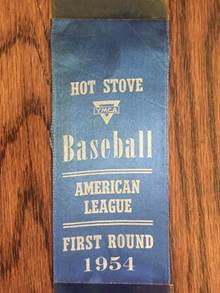
Best All-Time Players – Who’s on First?: To date, grandson Ian and I have selected these positions in our all-time lineup: Left Field – Ted Williams with a special nod to Stan Musial; Center Field – Willie Mays; Right Field – Hank Aaron (Ian) and Babe Ruth (me); Third Base – George Brett (but we acknowledge a hometown bias and recognize Mike Schmidt as a worthy alternative); Shortstop – Honus Wagner; and Second Base – Rogers Hornsby (me) and Jackie Robinson (Ian – kid has a keen sense of history; also looks good in his fall league uniform; the dirty pant leg was caused by a skillful slide at home plate).
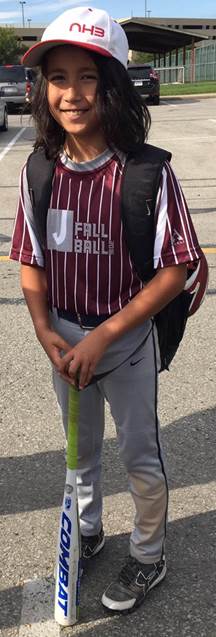
First Base? Who else? Lou Gehrig! Ian and I agree that this is one of the easiest choices in picking an all-time lineup.
Gehrig has the numbers, personality and class that make this a no-brainer choice. He has a career WAR of 112.4, best among all first basemen even though his career was cut short by ALS. As a member of the “Murderers’ Row” Yankees of 1927, possibly the best team of all time, he was the American League MVP, beating out Babe Ruth who hit his then record 60 homers. He continued with big years through most of the 30’s, including knocking in 184 runs in 1931, still an AL record. One of the primary legacies of the ”Iron Horse” is Gehrig’s 2,130 consecutive game streak that was finally surpassed by Cal Ripken in 1995.

There were many great sluggers in the 30’s, and Bill James has written about the cluster of talent at first base. Hal Trosky drove in 142 runs in 1934 and 162 in 1936, but he was the fourth-best first baseman in the AL. He was competing head to head with Gehrig, Jimmie Foxx and Hank Greenberg. These three are considered by many to be among the top five first baseman of all time and are in this photo of 1937 all-stars (Gehrig, Joe Cronin, Bill Dickey, Joe DiMaggio, Charlie Gheringer, Foxx and a very tall Greenberg – all seven are in the Hall of Fame):
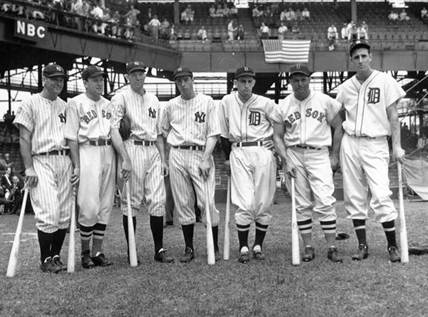
The player who will likely become the consensus second best all-time first baseman is Albert Pujols of the Cardinals and Angels. With a career WAR to date of 101.1, he has a chance of catching Gehrig in that stat. Pujols has been MVP three times and placed second four other times, twice behind the “new and improved” older Barry Bonds. If the steroid years for Bonds are discounted (as they have been so far by the Hall of Fame), Pujols would have at least five MVP awards. Other than Bonds, no player has won more than three. The good news is that you can still watch this first ballot Hall of Famer at the K when the Angels come to town next season (and as a bonus, you will see another likely first ballot guy, Mike Trout).
Any talk of first base should also include Buck Leonard, the player known as the “black Lou Gehrig” and the first baseman on the Field of Legends at the Negro Leagues Baseball Museum. After Satchel Paige was inducted into the Hall of Fame in 1971, the next two from the Negro Leagues were Buck Leonard and Josh Gibson (the “black Babe Ruth) who together led the Homestead Grays to nine Negro League pennants. Leonard and Gibson were approached in 1943 by Clark Griffith of the Washington Senators about breaking the color line in the major leagues. They said they were interested, but Griffith never called back. Buck O’Neil in his autobiography said of Leonard, “We share the same nickname, and I only wish I’d had half his talent.” He says that Leonard could hit like Gehrig and was a better fielder. O’Neil also tells the story of how Leonard turned down Bill Veeck’s offer to play in the majors. Leonard, then well past his prime, said he declined because the fans would not see the real Buck Leonard. [Trivia: in some circles, Ruth was the “white Josh Gibson” and Gehrig was the “white Buck Leonard”]

Lou Gehrig in Kansas City, New York and the Hall of Fame: As reported in Hot Stove #21, Lou Gehrig played the last game of his career in an exhibition against the Yankee’s farm team, the Kansas City Blues. Gehrig had ended his 2,130-game streak by taking himself out of the Yankee lineup on May 2, 1939. Although he continued to suit up, he never played another major league game. He came to Kansas City for a June 12 exhibition and played three innings. I recently received more details on Gehrig’s KC game from Hot Stove reader Paul Donnelly. Paul has been researching Kansas City newspaper archives for a book he is writing, and he kindly diverted his attention to Gehrig to come up with several clippings for me on that Yankees/Blues game. At the time, there were three daily papers: The jointly owned Kansas City Times (morning) and Kansas City Star (evening) plus the Kansas City Journal which folded in 1942.
On June 11, the day before the game with the Blues, the Yankees swept a double-header from the St. Louis Browns. The Star, with a St. Louis byline, reported that Gehrig had disclosed that he would be going to the Mayo Clinic after the exhibition game in Kansas City – “Gehrig looked thin and drawn as he announced his decision…but insisted that he expected to return to his position during the summer.” The Journal printed the likely starting lineups for the KC game, and Babe Dahlgren was listed as the first baseman. With the exception of Dahlgren and Charlie Keller, the lineup was the same as the one that swept the Cubs in the 1938 World Series.
The 1939 Blues team was considered one of the best minor league teams in history. The double play combination of Phil Rizzuto and Gerry Priddy were touted to be the successors to Frankie Crosetti and Joe Gordon of the Yankees. Joe DiMaggio’s older brother Vince was in center field and at the time of the Yankee game was leading all leagues, major and minor, in home runs.
The Star’s evening edition of June 12 reported on the pre-game activities. The overflow crowd “occupied every vantage spot in the park, with fans perching on tops of park refreshment stands and jamming the top concrete ramp and the several acres of ground north of the left field stands. Policemen formed a cordon around the boxes to keep eager fans off the field and away from the Yankee dugout…One by one the Yankees were introduced to the fans, to deafening cheers…Hours before…Crowds gathered in front of the Hotel President, blocking traffic and impeding progress of the Yanks on the way to the ball park.”
The full game was reported the next morning by the Times. The front page story colorfully discussed the record crowd of 23,864 fans, “but at least 8,000 so-called spectators…spent two hours looking at the backs of the necks, the headgear and the flaring ears of taller Americans, hollering now and then ‘Hey, what’s happened now’…One little fellow said bitterly he never knew they had rounded up all the jumping centers in basketball and given them proxy to the best standing room…Other thousands of the general admittance patrons, most of them seeking to avoid such ailments as bunions and falling arches, had scurried to the outlying , seatless zones on the right field bank and the left field foul line.” The photo below was in Hot Stove #21, but it’s worth repeating:
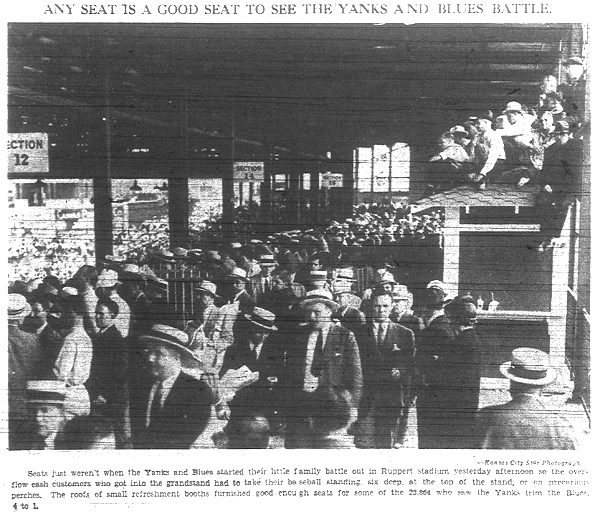
That crowd got something special. Lou Gehrig started at first base. He went hitless in one at bat and got four put outs at first in the three innings he played. The Times reported that he “left the contest when he was unable to field a ground ball toward his first base position.” Babe Dahlgren replaced Gehrig and had three hits and knocked in two runs in the Yankees 4-1 victory. The box score from the Times:
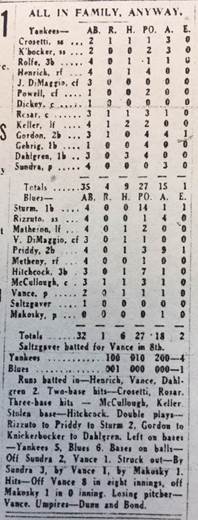
Rather than traveling with the team after the game, Gehrig took a train from Union Station to the Mayo Clinic. It was determined that he had amyotrophic lateral sclerosis (ALS), now commonly known as Lou Gehrig’s Disease. Three weeks after he played the game in Kansas City, he appeared in Yankee Stadium on July 4 to deliver his echoing farewell in what is described as baseball’s Gettysburg Address: “Yet today I consider myself the luckiest man on the face of the earth.” The video here.
In August, he gave a radio interview on the condition that they not question him about his illness. He commented on night baseball (just a “show“ that was “strictly advantageous to the owners’ pocketbook”), the top 3 ball players in history (Ruth, Cobb, Wagner), upcoming star (Ted Williams, a rookie in 1939) and the possibility of a players union (he thought not), (click here, 7:14). [Union Trivia: Gehrig’s peak salary was $39,000 in 1938. Adjusted for inflation, that would have been $668,612 in 2016. The minimum salary in MLB in 2016 was $520,000. Albert Pujols pulled down $25,000,000.]
On December 7, 1939, the Hall of Fame held a special election and retroactively inducted Lou Gehrig as part of the class of 1939. He died in 1941 at the age of 37.
Who’s on First? – Abbott and Costello: Now we move from all-time best first baseman to all-time funniest baseball comedy routine. Abbott and Costello did various versions of the skit in the movies and on radio and television. They performed it several times for President Franklin Roosevelt. Here is the version from the 1945 movie The Naughty Nineties: (click here, 6:14).
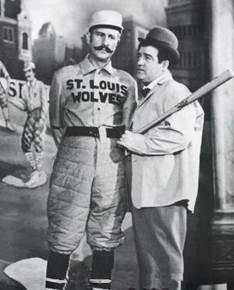
For the record (and to fill out your scorecard): 1B – Who; 2B – What; 3B – I Don’t Know; SS – I Don’t Care (sometimes I Don’t Give a Darn); LF – Why; CF – Because; RF – I would like to say “I don’t know,” but he’s the third baseman. Abbott and Costello did not identify the right fielder); P – Tomorrow; C – Today.
In 2007, the Dodgers called up shortstop Chin-Lung Hu. When he got his first major league hit, a single, Dodgers announcer Vin Scully proclaimed “Shades of Abbott and Costello, I can finally say Hu is on first base.” (click here, 0:15).
In 2012, Jimmy Fallon (Abbott), Billy Crystal (Who) and Jerry Seinfeld (I Don’t Know) teamed up to do a version of the classic routine and wore the uniforms of Bud Abbott’s St. Louis Wolves: (click here, 2:58).
Mitt (Abbott) and Newt (Costello) gave us this gem in the 2012 primary: (click here, 0:49).
Vin Scully, the NBA and Some Presidents: President Obama recently named Vin Scully as a recipient of a Presidential Medal of Freedom. When Scully joined other recipients at the White House, this wonderful photo was taken:
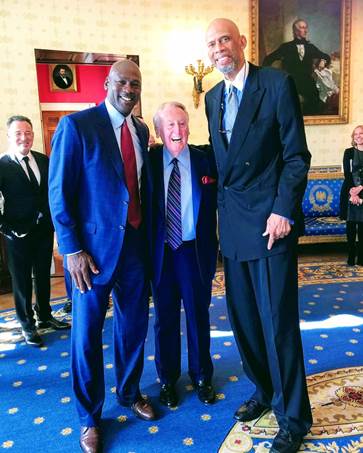
Joe Posnanski wrote about this and filled in the names of the men in the photo: Bruce Springsteen, President Grant, Michael, Vin, Kareem and President Tyler. Click here. Scully was informed of the award by White House Press Secretary and Kansas City native Josh Earnest who was just as excited about the award as Scully: (click here, 1:03).
As you know, I never pass up a chance for an anecdote about Hamilton (no, not the tiff between Donald Trump and the Hamilton cast). This clever parody of the opening song of Hamilton features actors portraying LeBron James and other NBA stars to tell the story of the rise of LeBron, (click here, 4:38).
James (of the Cleveland Cavaliers) and Dwayne Wade (of the Chicago Bulls) made a friendly wager on the outcome of the recent World Series. As we know, the Chicago Cubs came back from a 3-1 deficit to defeat the Cleveland Indians, just as James’ Cavaliers had done with the Warriors in the 2016 NBA finals. James paid off his bet last week by wearing a Cubs uniform during the pre-game at the Cavaliers/Bulls game in Chicago.
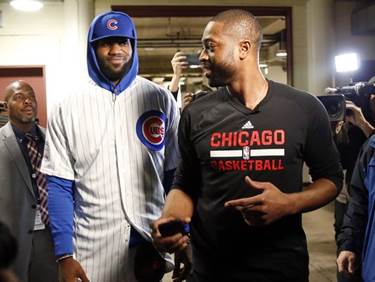
Movies and Music: In Hot Stove #24, I gave our reviews of movies we saw at the Telluride Film Festival. Many are now coming out and several are getting Oscar buzz. As a reminder, these included Manchester by the Sea, Moonlight, Arrival, La La Land and Bleed for This. Although The Eagle Huntress was at Telluride, we missed it there, but caught it at Tivoli last week – superb documentary. Not at Telluride, but looking forward to: Loving, Hidden Figures, Fences, Lion and Jackie. Two new albums were released last Friday. For those who have memorized the Hamilton cast album, there is a fun change of pace in the Hamilton Mixtape. And for those who thought the Rolling Stones were just an all-time great cover band for a younger version of themselves, their new album is a splendid set of covers of Chicago bluesmen who influenced the Stones music (Howlin’ Wolf, Little, Willie Dixon and others) – Blue and Lonesome. In 1963, the Stones toured with and opened for another major influence, Little Richard, who turned 84 today. I still have my 45 rpm vinyl copy of Little Richard’s “Tutti Frutti.”
Hot Stove Coming Attractions: With our trip to Cabo coming up, and then the holidays, the next Hot Stove may not surface until the start of 2017. In the meantime, HAPPY HOLIDAYS!